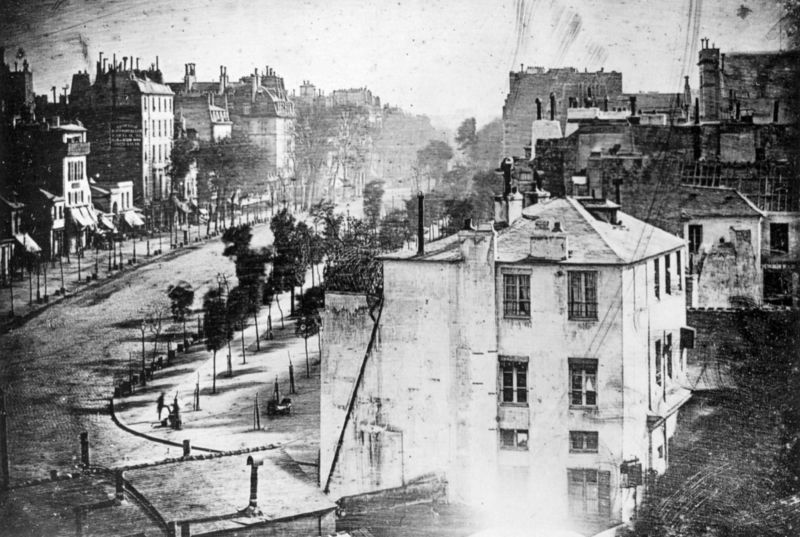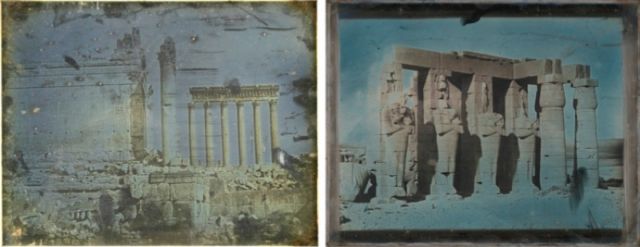https://arstechnica.com/?p=1519385

The earliest reliably dated photograph of people, taken by Louis Daguerre one spring morning in 1838.
Public domain
Daguerreotypes are one of the earliest forms of photography, producing images on silver plates that look subtly different, depending on viewing angle. For instance they can appear positive or negative, or the colors can shift from bluish to brownish-red tones. Now an interdisciplinary team of scientists has discovered that these unusual optical effects are due to the presence of metallic nanoparticles in the plates. They described their findings in a new paper in the Proceedings of the National Academy of Sciences.
Co-author Alejandro Manjavacas—now at the University of New Mexico in Albuquerque—was a postdoc at Rice University, which boasts one of the top nanophotonics research groups in the US. That’s where he met his co-author, Andrea Schlather, who ended up in the scientific research department at the Metropolitan Museum of New York. The Met has a valuable collection of daguerreotypes, and her new colleagues were keen to find better methods for preserving these valuable artifacts.
Schlather contacted Manjavacas and suggested this might be a great place to apply their combined expertise in nanoplasmonics—a field dedicated to detailing how nanoparticles interact with light. Think of it this way: light is an optical oscillation made up of photons. Sound is a mechanical oscillation made up of quasiparticles known as phonons. And plasma (ionized gas, the fourth fundamental state of matter) oscillations consist of plasmons. Surface plasmons play a critical role in determining the optical properties of metals in particular.
All photography dates back to an ancient optical effect known as the camera obscura, in which inverted images of external scenes or objects form on a white surface within a darkened chamber. A pinhole camera works much the same way. But nobody could figure out how to fix those ephemeral images for posterity, although 18th-century novelist Charles-Francois Tiphaigne de la Roche envisioned a world in his novel, Giphantie, where it was possible to do so by coating a canvas with a wet, sticky substance, and then letting it dry in the dark to preserve the captured image. He wasn’t that far off the mark. By the end of the 1700s, scientists had realized that silver chloride and silver nitrate would darken when exposed to light, a photochemical effect that would soon make photography possible.

Examples of a gilded (left) and unglued (right) daguerreotype created in 1844 by Joseph-Philabert Girault de Prangey.
A. Schlather et al.
Nicephore Niepce is now widely credited with taking the first still photograph in July of 1827, using a material that hardened when exposed to light to capture the image. But it took a full eight hours of exposure, and the image was temporary. Louis Daguerre built on Niepce’s work, figuring out how to reduce exposure times and fix the images by immersing the photographic plates in a salt solution. Introduced in 1839, his “daguerreotypes” were all the rage for several decades—Abraham Lincoln and Emily Dickinson were among the luminaries whose portraits were captured this way, along with the transit of Venus and the horrors of the American Civil War.
The basic process involved polishing a silver-plated copper substrate until it shone like a mirror and then treating it with fumes to make it light sensitive. The plate would be inserted into the camera and exposed for however long was necessary to capture the desired latent image. Fumes of mercury vapor would reveal the image, and the plate would be rinsed and dried to reverse the light sensitivity before placing it under glass to preserve it for posterity.
For their experiments, Manjavacas and Schlather figured a good place to start was to gain a better understanding of what is going on microscopically at the nanoscale with this process. Of course, 19th-century daguerreotypes are very fragile and highly valuable, so it wasn’t possible to conduct the kind of experiments required on the originals. “We needed something where we could literally break pieces apart,” said Manjavacas.
“Daguerreotypes rely on light scattering by metallic nanoparticles to create an image that projects off a reflective silver substrate.”
So they brought in co-author Michael Robinson, one of the top daguerreotype artists in the world, who wrote his PhD thesis on the techniques and aesthetics of this type of photography. Robinson was able to fabricate original daguerreotypes in strict accordance with 19th-century techniques, so experiments could be done without worrying about damaging period photographs. They tested their experimental findings with computer simulations of the electromagnetic effects.
Daguerreotypes are made with polished silver plates, and the salt added in the latter stages of processing contains gold atoms. So perhaps it’s not surprising that the researchers found metallic nanoparticles. The size and shape of those nanoparticles influence the optical properties of the final product because they determine which wavelengths of light are scattered off the surface and which are absorbed, yielding different hues. Specifically, the scattering spectrum showed a narrow blue peak in the UV range, and a broader red peak. This is why a daguerreotype will have a bluish tone when viewed from above, and shift to brownish-red hues as the viewing angle increases. And no two daguerreotypes are exactly the same.
“Daguerreotypes, unlike other types of photograph, rely on light scattering by metallic nanoparticles to create an image that projects off a reflective silver substrate,” the authors wrote. “The balance between the light scattered by the nanostructure and the spectacular reflection on the substrate creates the bright and dark tones, respectively, with the behavior of the midtones depending on the density of the nanostructures.”
-
Scattering intensity diagrams for nanoparticles of varying size and shape.
A. Schlather et al.
-
Viewing angle dependence of the daguerreotype image.
A. Schlather et al.
It’s a similar phenomenon to the one responsible for the shifting colors of a famous Roman drinking goblet. Dating back to around 400 CE and made of dichroic glass, the Lycurgus Cup is notable for exhibiting different colors depending on the light. (It gets its name from the scene depicted on its surface, of King Lycurgus of Thrace.) Light it from the front, and the cup looks green; light it from behind, and the color changes to a deep red. Exactly why this occurred was a mystery until 2007, when a team of scientists discovered the color shifts were due to the presence of nanoparticles in the glass—the result of Roman artisans adding finely ground gold and silver into the mix. Those nanoparticles change how the electrons in the cup vibrate in response to light so that the color one sees shifts with the observer’s vantage point.
“The Romans knew that if they added salt when they melted the silicon (sand) to make the glass, those salts contain gold atoms,” said Manjavacas. “In the melting process, those atoms aggregate and produce nanoparticles, and that’s how they got the colors. That’s how any stained glass is made.” It’s similar to how the precise lattice-like structure of photonic crystals produces iridescent colors in nature, like the wings of butterflies, or opals.
Like the Lycurgus Cup, the unusual color properties of 19th-century daguerreotypes are the result of the scattering properties of nanoparticles, according to Manjavacas. There is a key difference, however: the nanoparticles are embedded into the glass of the cup, whereas with a daguerreotype, they are sitting on top of a substrate, adding some reflection that does not occur with an artifact like the Lycurgus Cup. “In our case, the scattering of the particles has a strong dependence on the substrate,” said Manjavacas.
The team also discovered that if they coated the surface of the daguerreotype with a layer of gold, the colors shifted more to the red side of the spectrum. That’s in keeping with a 19th-century trick called “gilding,” in which the photographer would apply a solution of gold salt to the image to achieve warmer tones and sharper contrast.
Plasmonic nanoparticles (gold, silver, and platinum, most notably) are “tunable,” because one can alter their size and shape to tweak the optical properties of the metallic material. That’s a highly desirable feature for all kinds of practical applications. Schlather’s interest, of course, lies in developing better preservation methods for 19th-century daguerreotypes. If, for instance, an analysis reveals the nanoparticles in a given artifact are growing larger, it might be because of the UV light used in the display. A museum can correct for that to ensure its collection doesn’t deteriorate further.
Manjavacas is also interested in developing novel color printing technologies, such as using the plasmonic properties of aluminum nanorods to make color filters for flat panel displays—or to create anti-counterfeit watermarks on currency, since the nano aspect makes it possible to create pixels as small as one micron. “In this sense, daguerreotypes can be considered the first realization of plasmonic color printing,” the authors wrote. “Indeed, novel proposals for the fabrication of these devices resemble daguerreotypes.”
DOI: PNAS, 2019. 10.1073/pnas.1904331116 (About DOIs).
via Ars Technica https://arstechnica.com
June 12, 2019 at 10:08AM
